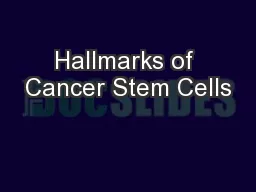PPT-Hallmarks Naralys Batista
Author : anastasia | Published Date : 2022-07-01
January 7 2014 Funding for this workshop was provided by the program Computational Modeling and Analysis of Complex Systems an NSF Expedition in Computing Award
Presentation Embed Code
Download Presentation
Download Presentation The PPT/PDF document "Hallmarks Naralys Batista" is the property of its rightful owner. Permission is granted to download and print the materials on this website for personal, non-commercial use only, and to display it on your personal computer provided you do not modify the materials and that you retain all copyright notices contained in the materials. By downloading content from our website, you accept the terms of this agreement.
Hallmarks Naralys Batista: Transcript
Download Rules Of Document
"Hallmarks Naralys Batista"The content belongs to its owner. You may download and print it for personal use, without modification, and keep all copyright notices. By downloading, you agree to these terms.
Related Documents














